|
|
| |
| מוזיקה |
| |
Duke Ellington - A life in music |
|
|
|
|
Duke Ellington - A life in music
|
|
|
|
|
Duke Ellington is without a doubt the most important and influential artist in the history of jazz, with the possible exception of Louis Armstrong, who is in line with him.
Born in 1899 in Washington, D.C., he played and led various jazz ensembles until his death in 1974. His life story embodies the history of mainstream jazz in the twentieth century.
His character was burned into the cultural consciousness as a noble prince of jazz music.
Duke was a wonderful pianist, composer, arranger and conductor. He wrote hundreds of works and recorded hundreds of studio and live recordings. He has experienced a large variety of line-ups:
duos, piano trios and big bands in various volumes. Collaborated with the greatest jazz artists of his time, musicians and vocalists. His fame was world-wide already during his life. he is considered
In the eyes of many as good as the great composers of the 20th century in the United States. Duke left behind a treasure trove of written music in various structures and ensembles (orchestra, sextets, octets and more)
And even composed music for one movie
1
.
|
|
It is difficult, in fact impossible, to summarize Duke Ellington in one article. This requires a much wider format. Still, I will try to touch the tweezers here on the main points
and the important and direct the curious listener to particularly important albums.
Duke gave birth to artistic jazz. In his youth, the 1920s and 1930s, jazz was actually music of dancing and funerals. That's how it was born in New Orleans, the homeland of jazz.
The favorite form of entertainment for blacks in the United States was dancing to the sounds of cheerful jazz music combined with comedic performances in the various styles of the period (ragtime, woodville).
Already listening to his first composition The Washingtonians, which was very successful in New York of the late 1920s (see The Cotton Club), Duke's genius is evident.
The elaborate orchestras and arrangements were exceptional; Different and strange melodies (instrument combinations); All of these added a new dimension to light jazz music - an artistic one.
Duke Ellington is the first 'serious' musician in the history of jazz (for comparison - New Orleans Rhythm Kings, Fletcher Henderson, King Oliver’s Creole Jazz Band).
There are quite a few analogies on discs from the early period of Duke. Despite the bad sound, I find listening to this music a very enjoyable and enriching experience -
great music and a jazz school together.
Racism
Duke was already successful in the 1920s but most of his audience was black. Few whites attended these 'black' performances despite the influence of black music
was big (the first jazz album recorded was of a white band and was successfully distributed in Europe as well). At the Harlem Cotton Club it was where Duke burst into the public consciousness
(House Orchestra). Entrance to black audience was forbidden. The separation was severe. It was Duke that demanded and also managed to get a black audience into the club (1931). In the 1930s
Duke hired a private train for his orchestra for a tour in the racist south. For blacks, traveling by regular transportation was a difficult experience. In contrast, in Europe of that period
Duke and his orchestra were received with great respect, to the point of applause as they took the stage (Europe was a haven for quite a few big black musicians against the racist
background in the United States). The big turning point came in 1943 at the premiere concert of Duke and his orchestra at the famous Carnegie Hall in New York; The stronghold of white culture,
the most important concert hall in the world. This time the crowd was mixed, white and black, and from all walks of life. Here Duke was breaking barriers. He performed on stage his work Black,
Brown and Biege which presents, according to Duke, the story of blacks in America (in 1958 it was expanded to a suite in an album bearing the name of the work). At his second appearance at
Carnegie in 1952, Duke was joined by Billy Holiday, Charlie Parker, Dizzy Gillespie, Stan Getz and Ahmed Jamal (premiere!). Duke Ellington reappeared there three more times.
According to Laura Townshend
2
, Duke has five main points about racism:
- Saw music as a form of social activism. "Music reaches people where words can't".
- He wanted to be perceived as an artist first, obviuosly regardless of his skin color.
- Used his performances to refute racist stereotypes.
- Fracture of race barriers with Black, Brown and Biege at Carnegie Hall 1943.
- Use Black, Brown and Biege to share the stories of the black experience with the whites.
|
|
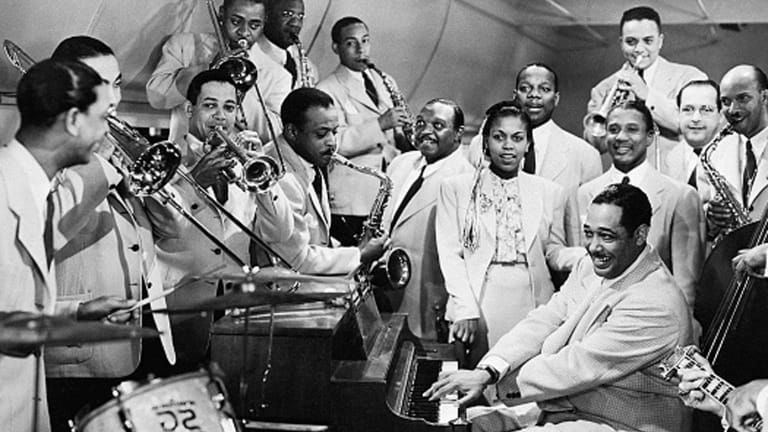
Duke in the 1930s
|
|
|
The players
Over the years, Duke has concentrated tremendous jazz musicians in his various ensembles. Some have made significant contributions
to his musical development thanks to their excellent ability to play, compose and arrange. To mention the important ones:
- Johnny Hodges - alto sax
- Paul Gonsalves, Ben Webster - tenor sax
- Harry Carney - baritone sax
- Juan Tizol - trombone (composer of Caravan, Perdido etc.)
- Bubber Miley, Cootie Williams, Cat Anderson, Clark Terry - trumpet
- Ray Nance - violin, trumpet, vocals
- Barney Bigard - Clarinet
- Jimmy Blanton - double base
- Sonny Greer - drums
The 1950s
For those looking for the really good quality recorded music of Duke, these are the years to focus on. After a decline in previous years that occurred for various reasons,
Duke experienced a resurgence after performing at the Newport Jazz Festival, 1956. The recorded album was the best-selling of his career
3
. He renewed the contract with
Columbia Record Company and began recording in March. In the late fifties, some real masterpieces were released:
- Such Sweet Thunder
- Ella Fitzgerald sings the Duke Ellington Songbook
- Ellington Indigos
- Back to Back
- Side by Side
- Blues in Orbit
- Anatomy of a Murder
In 1959, Duke Ellington and Billy Strayhorn composed the music for Otto Preminger's Anatomy of Murder (starring James Stewart and Lee Remick).
The album came out the same year in the performance of the Duke Orchestra. The soundtrack is considered a landmark - the first of black
American musicians and in addition, non-fiction music that accompanies a film. The original soundtrack has 13 tracks that are all on the album.
The sound quality is excellent, a great experience when heard from a fine stereo system.
|
|
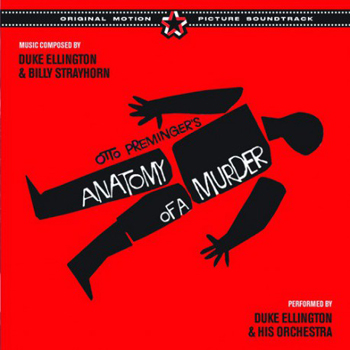
Anatomy of a Murderer, 1959
|
|
|
Later years 1960s - 1974
Duke conducts extraordinary activities of concert tours all over the world and various collaborations (see below).
Many recordings including a series of concerts at Carnegie Hall (Scared Concerts), piano trio ensembles and even
solo piano recitals (see below - piano accuracy). Duke recorded a series of orchestral suites most of which were influenced
from his experiences in his travels around the world.
|
Career collaborations
Johnny Hodges
Born in 1907, Hodges was one of jazz's greatest alto saxophone players. He was highly regarded by musicians such as Benny Goodman,
Charlie Parker, Ben Webster and John Coltrane. The collaboration between him and Duke Ellington lasted for decades, almost in
complete succession. Hodges joined the Duke Orchestra in 1928 on the recommendation of Barney Bigard.
He soon became the leading alto player in the orchestra and his sound became one of its hallmarks - Duke called it 'intense ecstasy';
It was a unique sound - clean and clear, both melodic and bluesy; Beautiful vibrato and romantic glides between sounds. Duke wrote
pieces especially for Hodges as lead singer with the orchestra. Listen for example to Prelude to kiss and Haupe.
Hodges reached the status of a jazz star in his own right and accurately recorded two albums in duet format - Back to Back,
Side by Side. Both are photographed on the cover as equal partners (1959).
Billy Strauhorn
Duke and Strayhorn maintained a complex relationship for 30 long years, until Strayhorn's death in 1966. Billy Strayhorn,
a gifted pianist, composer and arranger was Duke's right hand. He gained Duke's affection and immense appreciation for seeing
him as a kind of twin brother to his musical path. He had a classical musical education and he adapted and polished many
Duke's works alongside his own works. As a composer he took refuge in the shadow of Duke and often did not gain
credit as a writer; Against this background, frustration grows over time. However, Duke did not really take advantage of
Strayhorn as it was the case in the music world among others. Staryhorn was his best friend. Among Streihorn's well-known
works can be found:
- Take the A Train
- Lotus Blossom
- Chelsea Bridge
- Rain Check
When Streihorn died of cancer in 1966 Duke sank into heavy mourning. In '67 he dedicated to him the album And his mother
called him Bill, all from the works of the deceased, some in a premiere recording. Notice the stunningly beautiful passage
Blood Count, Streihorn's latest work written in his hospital hospital bed shortly before his death;
The melody is wonderfully played by Johnny Hodges. (See also Joe Henderson's performance, below). In After All,
Paul Gonzalez responds with a beautiful solo of his own. At the end of the session while the orchestra was packing,
Duke sat down at the piano and spilled on the Lotus Blossom section. This is the section that seals the album;
Luckily enough the microphone stays open. The album won rave reviews and a Grammy Award.
Duke Ellington - Lotus Blossom
For further acquaintance with Strayhorn's work I highly recommend Joe Henderson's wonderful album Lush Life (Verve, 1992).
|
|
|
Billy Strayhorn (1915-1967)
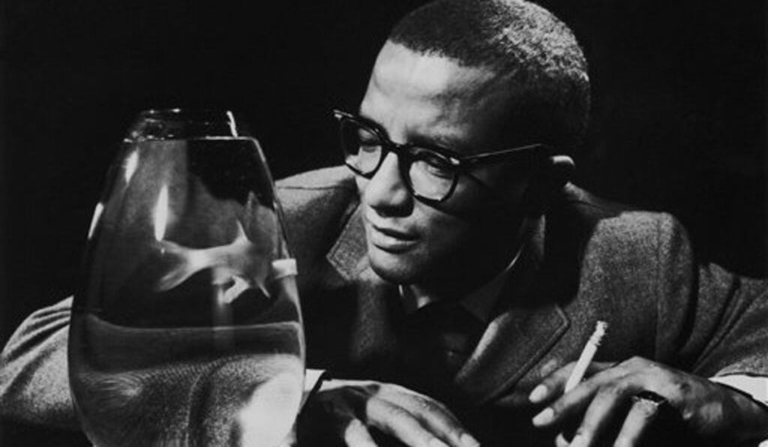 |
|
|
|
In the early 1960s, Duke collaborated with huge jazz musicians including Count Bassey, Louis Armstrong, Coleman Hawkins,
Charlie Mingus and John Coltrane.
Louis Armstrong
In 1961, the two great jazz giants met for a one-time meeting at RCA Victor Studios, New York. Louis brought with him
musicians from his band All All Starts and Duke brought with him The wonderful clarinetist Barney Biggard. They recorded
17 classic pieces of precision that were released on two separate albums that year - Together for the first time and
The Great Reunion. Among the tracks can be found:
In a Mellow Mood, Duke’s place, Moon Indigo, Solitude.
Charlie Mingus
In 1962 three giants met together at the Sound Maker recording studio in New York. Duke, age 63, along with two of the
greatest modern jazz musicians of the time, the bass player And composer Charlie Mingus and drummer Max Roach.
Mingus, who was a jazz icon in his own right, was considered Duke's successor over the years; Duke was his idol from
a young age and an inspirational model. The first meeting between them took place on stage in 1953 and ended with
the dismissal of Mingus after a quarrel that almost escalated into violence between him and trombone player Juan Tizol.
According to Mingus, Tizol threw at him a remark that sounded racist after playing the role of bass octave above what
Tizol demanded. A note led to a heated argument in the end Tizol pulled out a knife. Mingus was a young 21-year-old and
hot-tempered, but it seems that the white and Puerto Rican Tizol also had his own temperament… (the story
has several other versions). Nine years later Duke and Mingus met again and this time in the recording studio. The album was
initiated by Duke who wanted to record a piano trio. Producer Alan Douglas offered Mingus and it insisted on bringing
'ith him Roach. Duke brought with him all but one of the music pieces. The playing style is tagged as post-pop, a definition
that doesn’t fit in to my opinion; It's hard to label it stylistically and neither should. The importance of the album is
in the encounter between individual musicians and those with different styles who supposedly do not connect (the critique
referred to this at the time). Despite this and perhaps thanks to it a unique session was created that greatly influenced
many musicians and modern jazz in general.There is a renunciation of ego and a pure concentration on music. Listening to
this album is pure pleasure.
|
|

Money Jungle, 1962
|
|
|
John Coltrane
Less than nine days into the session with Mingus and Duke, there is another one-time encounter with one of the younger
generation's modern jazz giants, saxophonist John Coltrane. Coltrane, Who was in 1963 at the height of his commercial
success with his classical quartet, acceded to Impulse's house release request and released a small series of three
melodic jazz albums; These were a welcome respite from his bold style of dismantling traditional jazz. The first of which
was this encounter with Duke (followed by Ballads, and a meeting with jazz singer Johnny Hartman). Duke and Coltrane
brought with them their bass player and drummer and these exchanged with each other in the various sections. The most
sections. The album brought precision, one by Strayhorn and one by Coltrane. This is a relaxed encounter of two artists
who have never met before. Coltrane, he said, saw this meeting as a great honor.
|
|
|
Duke Ellington and John Coltrane
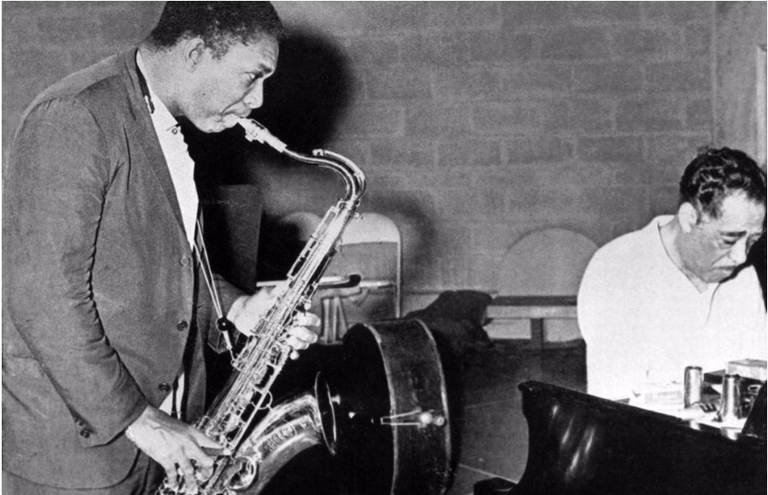 |
|
|
What led Duke Ellington, an icon and master of old jazz, to meet in the early 1960s at his 'extreme' age two of the most
daring and kicking musicians of new jazz? Appreciation, curiosity and challenge. Pure and completely egoless musical
encounters; An amazing and inspiring thing on any scale.
Duke the pianist
Too little attention is paid to Duke as a pianist among jazz lovers. Duke has recorded several studio albums with
duo-sized ensembles, all of which show his wonderful pessimism. A stunning combination of simplicity with harmonic
complexity, expression, timing and sound. Music full of rhythmic surprises; Duke did not fall for any of the great jazz
pianists of His time such as Earl Haynes, Errol Garner and even the legendary Thelonius Monk. Even if he had chosen a
career as a mere pianist he would have remained in his grandeur. In live performances on stage he occasionally took on a
solo piece and it was always a magical and mesmerizing respite amid the noise and bustle of the big ensembles. Here are
two more studio albums with Duke as a pianist from the ensemble:
|
|
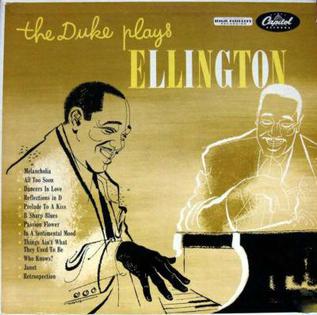
The Duke Plays Ellington, 1953
|
|

The Pianist, 1966,70
|
|
|
Duke on the stage
We will mention three recorded concerts out of dozens:
- The Carnegie Hall Concerts, 1943, חשיבות הסטורית
- The Armory Concert, 1955 (קהל של 10000 איש)
- Ellington at Newport, 1956
The Importance of Duke Ellington
- He gave birth to artistic jazz. Exploring different musical forms - up to orchestral suites - different
ensembles and more. Sophisticated arrangements, new melodies and more.
- Gave place to the virtuoso lead singer. Excerpts were written especially for the various soloists to
show their ability to play and express themselves, including exceptionally long solo excerpts for the period.
- Reference in music to discrimination and racism.
- A huge composer. Some consider it a great American composer of the twentieth century.
- A wonderful pianist.
Hits and classics
- The Mooche
- Moon Indigo
- Sophisticated Lady
- Solitude
- Caravan
- Prelude To a Kiss
- Flamingo
- Perdido
- C Jam Blues
- Take the A Train
- Satin Doll
|
|
|
1
Anatomy of a Murder, 1959
2
Duke Ellington and Racism
3
In fact only some of the tracks on the album were recorded at the show. Duke, who was dissatisfied with the workmanship of more than half of the pieces, re-recorded them the next day
with background noises from a fake audience. It is not mentioned in the album text.
Ofer Shchori, 2022
Translated from Hebrew
|
|
For further reading
|
|
|